Oxford University Press's Blog, page 727
December 9, 2014
The Lerner Letters: Part 1 – The Stars
This is the first of a three-part series from Dominic McHugh on the correspondence of Alan Jay Lerner. The next installment will appear on Tuesday, 16 December 2014.
One of the joys of editing the correspondence of Alan Jay Lerner has been discovering his letters to and from the major stars with whom he worked. As the lyricist, librettist, and screenwriter of Brigadoon, Paint Your Wagon, An American in Paris, My Fair Lady, Gigi, Camelot, On a Clear Day You Can See Forever, and many more, he worked with the finest performers of his time. In this post, I’ll explore focus on his relationship with two of his stars: Rex Harrison and Julie Andrews.
Rex Harrison’s iconic performance as Henry Higgins was one of the keys to making My Fair Lady the most successful musical of the 1950s. He played the role for over a year in New York, opened the show in London, and went on to appear in the 1964 movie version (currently celebrating its 50th anniversary). But Fair Lady was Harrison’s first foray into musical theatre, and he found the process terrifying. The following letter was the first I found for my book, and it’s a wonderful insight into the writer-performer relationship. This excerpt shows how Lerner tried to lay Harrison’s fears about some of the initial songs they had written for him to rest:
[…] I was very interested in your comments about “Why Can’t The English,” and want you to know that I feel your reservations, as far as you are concerned, are completely justifiable. As I said in my cable, don’t let it tinge one hair with gray—we are rewriting it completely in a way that will be not only simpatico with you, but with the character of Higgins. I can do no other but agree with you when you are right, but I would fight you like a wounded tiger if I thought you were wrong.
 Photo of Julie Andrews and Rex Harrison from My Fair Lady. Eliza Doolittle, the flower girl, meets Professor Henry Higgins. NYC Public domain via Wikimedia Commons
Photo of Julie Andrews and Rex Harrison from My Fair Lady. Eliza Doolittle, the flower girl, meets Professor Henry Higgins. NYC Public domain via Wikimedia CommonsI might add, before closing the matter, that there are certain lyric liberties one can take when they are framed by certain kinds of melodies. There are “song songs” and “character songs.” A “character song,” which is basically free and is accompanied by an emotion or emotions, as is the case in “I’m An Ordinary Man,” must pretty much stay within the bounds of reason. In a “song song,” certain extravagances are not only permissible, but desirable. “Why Can’t The English,” written as it was, was definitely a “song song” and therefore contained a certain amount of satiric extravagance. The minute the same idea is written in a freer way, so that it almost seems like normal conversation set to music, those extravagances would seem definitely out of place. When one reads the lyric of a “song song” over and compares it to the character who is singing it, very often there will seem to be a discrepancy. For example, what business does a young Navy lieutenant have singing a poetic song like “Younger Than Springtime”?
The second paragraph is a particularly wonderful insight into the lyric writer’s mind, explaining how he viewed different kinds of songs. Another wonderful letter related to My Fair Lady shows how Lerner tried to persuade Julie Andrews – future star of the movies Mary Poppins and The Sound of Music – to arrive a little early for rehearsals. She had decided to spend New Year at home with her family in London because she knew she was about to start a long run away from them, but Lerner wanted her to come to New York early in order to rest and take part in publicity opportunities:
[…] I don’t know whether or not you have been aware of the explosive conversations that have been going on lately between Herman Levin and Lou Wilson. I might add that Herman has been doing the conversing and Lou the exploding. What it’s all been about is the matter of your being here on December 27th. I, of course, realize how much you would want to be with your family over New Year’s, but there are a few things involved that I beg you to consider. I am sure you know in advance that our desire to have you here on that date is no capricious whim on our part.
Both Rex and Stanley Holloway are arriving at that time. It is not at all uncommon for the stars of a play to make it their business to be in town a week before rehearsals for the express purpose of using that time for the good of themselves and the play. You are a star now, Julie, and I do think that as a well-meaning observer, as well as an active participant in these proceedings, it would be most impolitic to have them, who are two great and established artists, follow the usual pattern and you not do so. Even though we will not, of course, be working around the clock during that time, much can be accomplished in those few days. We can go over your new songs with you and get the keys set. If you feel it is necessary, you could freshen up your Cockney with Dixon. We could go over a couple of the scenes, which we would all like to hear, mainly for length, before the first reading on stage January 3rd. Besides that, there is that old devil Publicity, which, annoying as it is, is more annoying when it isn’t. It will also give you a chance to make yourself comfortable in your flat, and you will be rested and ready for the official first day of rehearsals January 3rd.
In spite of Lerner’s power of persuasion, Andrews chose to stay in England: as she explained more recently in her memoir Home, she found it a huge wrench to spend time away from her family, and her family life had been difficult. It’s well-known that she then struggled with early rehearsals for Fair Lady, which the director (Moss Hart) had to close down for a weekend while he spent time training for her the role of Eliza, line by line. But she quickly went on to be a star when the show opened in March 1956, and the rest is history.
These two excerpts show how the use of primary sources shed new light on the study of Broadway musicals. They provide a snapshot of the collaborations that are so important to the genre’s success. And in the case of Lerner, they show both his witty and charming personality and his incredible prose facility, something I feel is often overlooked.
In the next blog post, I’ll look at the letters from Lerner to Frederick Loewe, his most beloved composer collaborator, focusing on two letters from the 1950s and two from the 1980s.
Headline Image: Old Letters. CC0 via Pixabay
The post The Lerner Letters: Part 1 – The Stars appeared first on OUPblog.









 Related StoriesMusic from Scotland: a playlistRemembering the original On the Town during World War IICelebrating Julie Andrews
Related StoriesMusic from Scotland: a playlistRemembering the original On the Town during World War IICelebrating Julie Andrews
Parental consent, the EU, and children as “digital natives”
Children have become heavy new media users. Empirical data shows that a number of children accessing the internet – contrary to the age of users – is constantly increasing. It is estimated that about 60% of European children are daily or almost daily internet users, and therefore, by many they are considered to be “digital natives”.
However, in our view, the use of this “digital natives” concept is misleading and poorly founded, and is based on the assumption that children are quick to pick up new technologies. A recent EU Kids Online study invalidates this assumption. The study shows that even though children actively surf on various online applications, they lack digital skills such as bookmarking a website, blocking unwanted communications, and changing privacy settings on social networking sites. Many children are not capable of critically evaluating information and changing filter preferences.Interestingly, the lack of skills to perform specific tasks while being online does not impinge on children’s beliefs in their abilities – 43% of surveyed children believe to know more about the internet than their parents. At the moment, no correlation between this proclaimed self-confidence and their actual understanding of how internet works can be done due to the lack of data. Nevertheless, it is worth questioning whether, and to what extent, it is reasonable to expect that children understand the implications of their behaviour and what measures could mitigate children’s online risks in the most efficient and effective way.
It is probably closer to the truth to say that, in terms of privacy and data protection awareness, children are anything but “digital natives”.
Indeed, children’s actions online are being recorded, commercialised and serve for the purposes of behavioural advertising without them actually realising. This media illiteracy is tackled by awareness raising campaigns and policy measures on domestic and EU levels. However, it seems that these measures only partially address the challenges posed by children’s online engagement.
 Image credit: Classroom laptops, by R. Nial Bradshaw. CC-BY-2.0 via Flickr. This image has been cropped.
Image credit: Classroom laptops, by R. Nial Bradshaw. CC-BY-2.0 via Flickr. This image has been cropped.The European Commission (EC) seems to be in favour of legislative measures providing for a stronger legal protection of children’s personal data in the online environment. In Article 8 of the proposal for the General Data Protection Regulation, the EC introduces verifiable parental (or custodian) consent that would serve as a means of legitimising the processing of a child’s personal data on the internet.
Article 8 of the proposal foresees that parental consent would be required in cases where the processing operations entail personal data of children under the age of 13. The age of 13 would be the bright-line from which the processing of children’s personal data would be subjected to fewer legal constraints.
In practice, this would divide all children into two groups; children that are capable to consent (i.e. 13-18 year olds) to the processing of their personal data and children that are dependent on parental approval of their online choices (i.e. 0-13 year olds). Drawing such a strict line opposes the stages of physical and social development. Also, it requires the reconsideration of the general positive perception of the proposed parental consent from a legal point of view. In particular, it is necessary to evaluate whether the proposed measure is proportionate and whether it coincides with the human rights framework.
In a recent article published in the International Data Privacy Law Journal, we have analysed the proposal to distinguish between children younger and older than 13 years and found many practical and principled objections. Apart from the practical objections, which are often self-evident (e.g. what about the protection of children in the age group from 13 to 18 year old? How to ensure the enforcement of the proposed parental consent?), there are several fundamental problems with the proposed 13 years-rule.
The bright-line rule, which would require data controllers to obtain parental consent before processing personal data of children aged under 13, seems to be incompatible with the notion of evolving capacities. The proposed measure is based on the assumption that from the age of 13 all children are able to provide an independent consent for the processing of their personal data in the online environment. The proposed Article 8 ignores the fact that every child develops at a different pace and that the introduction of parental consent does not ensure more guidance regarding online data processing. We also regret that Article 8 in its current form doesn’t foresee a way in which children could express their own views regarding the data processing operation; the responsibility to consent would rest exclusively with a parent or a legal guardian. This set-up opposes the idea of children’s participation in the decision-making process that concerns them, an idea anchored in the UN Convention on the Rights of the Child (UNCRC) and that is recognised by both the EU and its Member States.
Finally, our analysis suggests that children’s rights to freedom of expression and privacy may be undermined, if the proposed parental consent is introduced. As a result of Article 8, children’s access to information could become limited and dependent on parents. Also, the scope of their right to privacy would shrink as parents would be required to intervene in children’s private spaces (e.g. gaming accounts) to make informed choices. Therefore, it can be observed that the introduction of parental consent contradicts the key principles of human rights law enshrined in the UNCRC.
Featured image credit: Student on iPod at school. Photo by Brad Flickinger. CC-BY-2.0 via Flickr.
The post Parental consent, the EU, and children as “digital natives” appeared first on OUPblog.









 Related StoriesWhy Republican governors embrace ObamacareGary King: an update on DataverseDoes absence make the heart grow fonder?
Related StoriesWhy Republican governors embrace ObamacareGary King: an update on DataverseDoes absence make the heart grow fonder?
December 8, 2014
Why Republican governors embrace Obamacare
The national headlines following the 2014 Midterm elections trumpeted the Republican success in seizing the majority in the US Senate and expanding its strength in the US House to record numbers since 1929. These wins were striking but hardly surprising given the tsunami of polls. The big news that continues to elude commentators are the Republican wins in gubernatorial elections – wins that may well have more impact on everyday lives than the Washington battle that pits a Republican Congress against President Barack Obama’s veto pen. Republicans not only pulled out wins in hotly contested battles in Florida, Kansas, Maine, and Wisconsin, but they also invaded Democratic strongholds by prevailing in Illinois, Maryland, and Massachusetts.
Will the GOP gubernatorial wins sweep in a revolution that, among other things, wipes out Obamacare’s centerpiece – the state’s decision to expand Medicaid? Many commentators are predicting just that – repeal or blockage of health reform. They often point to the fiery partisanship in Washington.
The talking heads are wrong. The raw partisanship in Washington cools in the hands of governors facing the nitty-gritty job of running their states – searching for revenues to design budgets and addressing the pressure from doctors and hospitals and advocates for the vulnerable.
Partisanship has been a tractor beam on many states. Democratic states have moved faster and further towards expanding Medicaid than their Republican counterparts, providing some credence to the recent reports that new Republican governors will hinder reform. What is striking, however, is that partisanship – and particularly steadfast GOP opposition to reform — has often been moderated or overridden by the real-world circumstances facing governors. What could possibly convince a politically skilled GOP governor to take on their party on such a high profile issue?
Carrots. The decision to adopt the expansion of Medicaid rests with states. The federal government has served up an enticing financial package: 100% of the costs for the first three years of the program and 90% afterward.
Hospitals that serve the uninsured and poor are facing dramatic reductions in federal government funding, leaving many to worry about dire financial crises. Medicaid expansion is a lifeline for these providers. It also may help state budgets by picking up the cost of caring for the uninsured, what is known as “uncompensated” or charity care.
Here is one of the most striking patterns in our era of partisan polarization: states with Republican governors in Arizona, Ohio, Michigan, Iowa, New Mexico, Pennsylvania, New Jersey, and others embraced Medicaid reform. In Arizona for example, conservative firebrand Governor Jan Brewer forced Medicaid reform through the state legislature as an imperative to create jobs, save hospitals, and ensure coverage for Arizona residents. Governor John Kasich passed it by going rogue on his Republican legislature by circumventing them altogether and risking a constitutional crisis.
The Republican recent romp has elected a new crop of pragmatic governors. Maryland Governor-Elect Larry Hogan and Illinois Governor-Elect Bruce Rauner seem poised to find a path forward to implementing reform. Florida’s Scott has supported Medicaid expansion in the past and may find more support in the GOP legislature now that the election is over. Some Republican governors favor reform in a modified form so they can publicly frame it as a “conservative model” that fits their states.
A new normal is arriving. The uncompromising push to repeal Obamacare is being replaced with a pragmatism geared to solving real problems. The irony of the GOP gubernatorial success in 2014 is that it may mark the turning point from vitriolic partisanship to real-world problem solving.
Headline image credit: Election vote. CC0 via Pixabay.
The post Why Republican governors embrace Obamacare appeared first on OUPblog.









 Related StoriesGary King: an update on DataverseThe food we eat: A Q&A on agricultural and food controversiesTouchy-feely politics
Related StoriesGary King: an update on DataverseThe food we eat: A Q&A on agricultural and food controversiesTouchy-feely politics
Soldiers, sources, and serendipity
Like much historical research, my chapter in the Britain’s Soldiers collection came about more or less by accident. It relates to an incident that I discovered in the War Office papers at in 2007. I was taking a group of History students from Northampton University to The National Archives in Kew, to help them with their undergraduate dissertations. I had a small amount of time to do some of my own research, so ordered WO 43/404. The title sounded promising: ‘A book containing copies of correspondence in 1761, relative to the Behaviour of the Duke of Richmond’s regiment & Militia at Stamford on the 15th April 1761’.
What arrived was a letter book. It immediately struck me as being unusual, as the War Office usually just kept in-letters, whereas this book copied both sides of a lengthy correspondence between the Secretary at War and various other protagonists. Something noteworthy had clearly occurred, and was therefore preserved, possibly as a precedent to inform future action. I was pushed for time, however, so I quickly photographed the whole book and returned to my students.
Four years later I finally had an opportunity to transcribe the letters. What emerged was a bizarre event. In brief, the Lincolnshire Militia was quartered in Stamford and a regiment of the regular army that was on the march approached the town. The regulars had such contempt for the militia that they marched straight in, disregarding the usual military convention that they send advance word, and proceeded to refuse any of the other courtesies that the militia attempted to offer them. The militia’s commander took such umbrage at these slights that he posted sentries at entrances to the town, ‘to prevent any armed Troops entering the Town for the future without my knowledge and consent’. When further regulars attempted to enter the town, the militia stopped them at the point of their bayonets and a fight ensued in which men were injured, and could have been killed.
This was more than a local scrap. Neither side would admit fault and so wrote to the War Office to intercede. Despite the fact that Britain was in the midst of the Seven Years War – the largest global conflict that Britain had then fought – the Secretary at War took the incident very seriously indeed, and the letter book records how the fallout preoccupied him for a further two months. The dispute even drew in the King himself, who as Commander in Chief was keen to preserve ‘that Equality and Harmony in Service which is so much to be wished and cultivated’.
I was intrigued by the story that emerged from this letter book, and a paper trail ensued as I attempted to flesh out the story with other sources. My attempts to find references to the affair in public sources such as newspapers drew a blank, and I had more luck in private family papers and local government records instead. This was not an incident that was publicly known about at the time, which perhaps explains why historians had overlooked it.
As a cultural historian, what drew me to this incident was that it was an example of people behaving oddly. It is often only when people are behaving abnormally that we get an insight into the normal expectations of behaviour that go unspoken – in this case, attitudes towards military precedence and masculine honour. I think that incidents like the one at Stamford in 1761 highlight the crucial significance of ‘polite’ and controlled conduct in the eighteenth-century military. To our eyes, the interpersonal conduct of Georgian army officers may seem terribly mannered – but this is clearly desirable when you have large numbers of men who are highly defensive of their status and armed to the teeth. Rather than just reconstructing micro-incidents like this for their own sake, therefore, it is helpful to think about them more anthropologically in order to shed light on the workings of a past society.
Headline image credit: Battle of Bunker Hill by E. Percy Moran. Public domain via Wikimedia Commons.
The post Soldiers, sources, and serendipity appeared first on OUPblog.









 Related StoriesThe hand and the machineThe history of the newspaperShakespeare folio number 233
Related StoriesThe hand and the machineThe history of the newspaperShakespeare folio number 233
The lake ecosystems of the Antarctic
Antarctica is a polar desert almost entirely covered by a vast ice sheet up to four km in thickness. The great white continent is a very apt description. The ice-free areas, often referred to as oases, carry obvious life in lakes and occasional small patches of lichen and mosses where there is sufficient seasonal melt water to support them. The majority of ice-free areas lie on the coastal margins of the continent, but there is a large inland ice-free region called the McMurdo Dry Valleys.
On the face of it Antarctica would appear to offer little in the way of excitement for anyone interested in the physical, chemical, and biological characteristics of lakes. However, surprisingly Antarctica possesses the most diverse array of lakes types on the planet. The ice-free areas, which are bare rock, carry freshwater lakes and saline lakes, some as salty as the Dead Sea. Between land and ice shelves there are remarkable so-called epishelf freshwater lakes, that sit on seawater or are connected to the sea by a conduit and are consequently tidal. Underneath the vast ice sheet there are numerous subglacial lakes, around 380 at last count, of which Lakes Vostoc, Whillans, and Ellsworth are the best known. Ice shelves that occur around the edge of the continent overlying the sea, carry shallow lakes and ponds on their surface, and there are lakes on many of the glaciers. Some of these are short-lived and drain through holes called moulins to the glacier base, while others are several thousands of years old.
Antarctic lakes are extreme environments where only the most robust and adaptable organisms survive. Temperatures are always close to freezing and in saline lakes can fall below zero. While there is 24-hour daylight in summer, in winter the sun does not rise above the horizon, so the Sun’s light energy that drives the growth of the phytoplankton through photosynthesis is much lower on an annual basis than at our latitudes. The food webs of these lakes are truncated; there are few zooplankton and no fish. They are systems dominated by microorganisms: microscopic algae, protozoa, bacteria, and viruses. All of the lakes apart from the most saline have ice covers, that can be up to five metres thick. Lakes on the coastal margins usually lose part or all of their ice covers for a few weeks each summer, but the inland more southerly lakes of the McMurdo Dry Valleys have thick perennial ice covers that contain rocks and dust that have blown off the surrounding hills. This ‘dirty’ ice allows very little light to penetrate to the underlying water column, so the photosynthetic organisms that live there are adapted to extreme shade.
 Miers Valley in the McMurdo Dry Valleys area. Photo by Saxphile. CC BY 3.0 via Wikimedia Commons.
Miers Valley in the McMurdo Dry Valleys area. Photo by Saxphile. CC BY 3.0 via Wikimedia Commons.It would be reasonable to assume that during the austral winter biological processes in lake waters shut down. However, that is not the case; life goes on even in the darkness of winter. Bacteria manage to grow at low temperatures and many of the photosynthetic microorganisms become heterotrophic. They eat bacteria or take up dissolved organic carbon and are described as mixotrophic (meaning mixed nutrition). In this way they can hit the deck running when the short austral summer arrives and they can resume photosynthesis. Even the few crustacean zooplankton stay active in winter and don’t exploit resting eggs or diapause. They are crammed full with fat globules, which together with any food they can exploit takes them through the winter. Their fecundity is very low compared to their temperate relatives, but with no fish predators they can sustain a population.
Shallow lakes and ponds on ice shelves and glaciers freeze to their bases in winter. Thus their biotas have to be able to withstand freezing and in the case of saline ponds, increasing salinity as salts are excluded from the formation of ice.
The most topical and currently exciting lakes are the subglacial lakes kilometres under the ice sheet. These represent the modern age of polar exploration because gaining entry to these lakes presents major logistic challenges. One of the major issues is ensuring that the collected samples are entirely sterile and not contaminated with microorganisms from the surface. Subglacial lakes have been separated from the atmosphere for millions of years and potentially harbour unique microorganisms. In the past few years the US Antarctic programme has successfully penetrated Lake Whillans and demonstrated that it contains a diverse assemblage of Bacteria and Archaea in a chemosynthetically driven ecosystem (Christner et al. 2014). The British attempt to penetrate Lake Ellsworth was unsuccessful, but there are plans to continue the exploration of this lake in the future. In the coming years these extraordinary aquatic ecosystems will reveal more of their secrets.
The delicate surface lake ecosystems of Antarctica appear to respond rapidly to local climatic variations and where there are long-term data sets, as there are for the McMurdo Dry Valleys, to global climatic change. Unlike lakes at lower latitudes they are removed from the direct effects of Man’s activities that have changed catchment hydrology, and imposed industrial and agricultural pollution. Antarctic lakes are subject to the indirect anthropogenic effects of ozone depletion and climate warming. The impact of these factors can be seen without the superimposition of direct man-made effects. Consequently polar lakes, including those in the Arctic, can be regarded as sentinels of climate change.
Headline image credit: Lake Fryxell in the Transantarctic Mountains. Photo by Joe Mastroianni, Antarctic Photo Library, National Science Foundation. CCO via Wikimedia Commons
The post The lake ecosystems of the Antarctic appeared first on OUPblog.









 Related StoriesChristmas for a nonbelieverIs your commute normal?How has World War I impacted United States immigration trends?
Related StoriesChristmas for a nonbelieverIs your commute normal?How has World War I impacted United States immigration trends?
December 7, 2014
AAR/SBL 2014 annual meeting wrap-up
Thanks to everyone who visited our booth at the American Academy of Religion/Society of Biblical Literature annual meeting this year! We had a great time in San Diego.
One of our favorite parts of the meeting was seeing many of our authors (and for many of us, meeting them for the first time!). Check out our slideshow below of some authors that stopped by our booth.
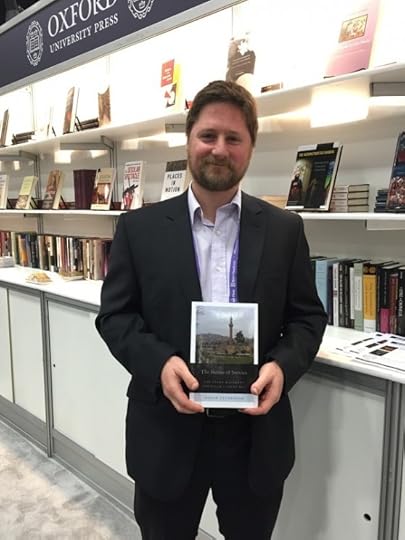
David Tittensor
David Tittensor displaying a copy of his book, The House of Service: The Gulen Movement and Islam’s Third Way
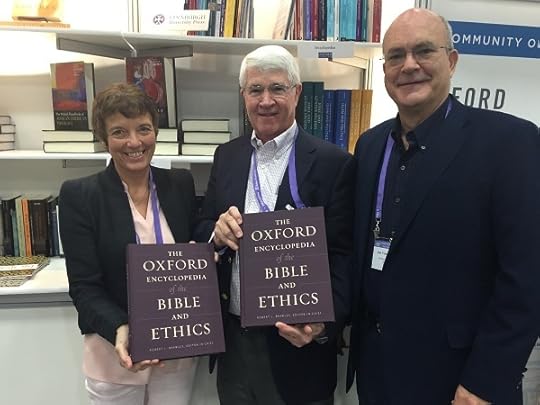
Robert Brawley, Kathy Ehrensperger, and Jan G. van der Watt
Robert Brawley, Editor-in-Chief of The Oxford Encyclopedia of the Bible and Ethics, with editorial board members Kathy Ehrensperger and Jan G. van der Watt

Andrea Jain
Andrea Jain, author of Selling Yoga: From Counterculture to Pop Culture, with her research assistant
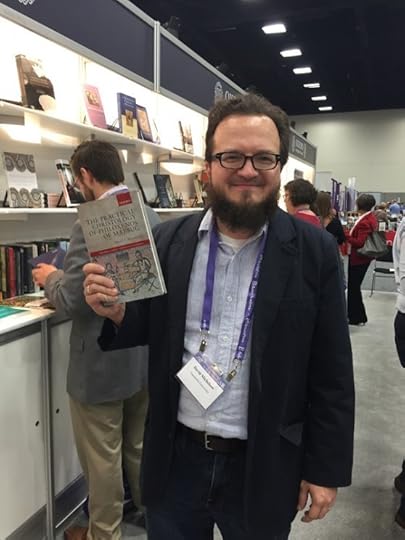
David Michelson
David Michelson, author of The Practical Christology of Philoxenos of Mabbug

Joydeep Bagchee
Joydeep Bagchee, co-author of The Nay Science: A History of German Indology
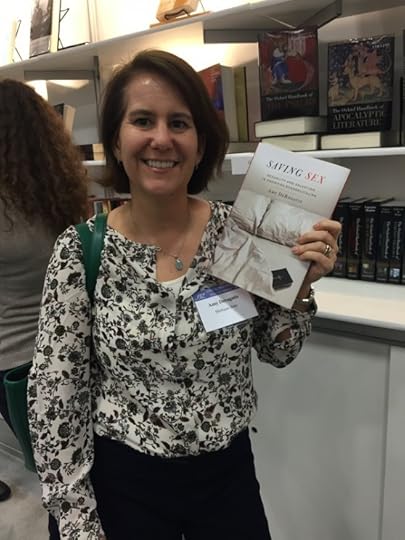
Amy DeRogatis
Amy DeRogatis with her newly published book,
Saving Sex: Sexuality and Salvation in American Evangelicalism
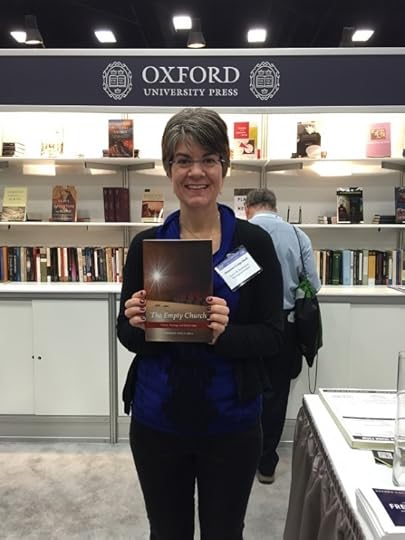
Shannon Craigo-Snell
Shannon Craigo-Snell with a copy of her book, The Empty Church: Theater, Theology, and Bodily Hope
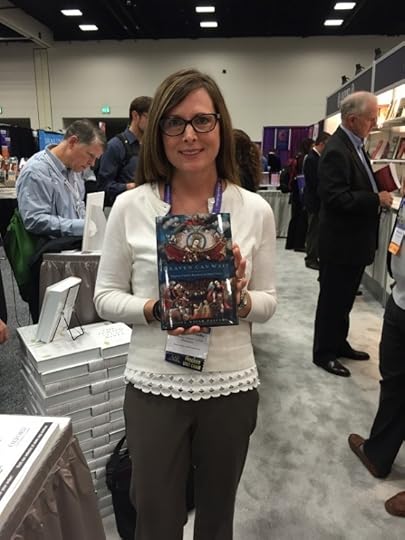
Diana Walsh Pasulka
Diana Walsh Pasulka holding a copy of her book, Heaven Can Wait: Purgatory in Catholic Devotional and Popular Culture
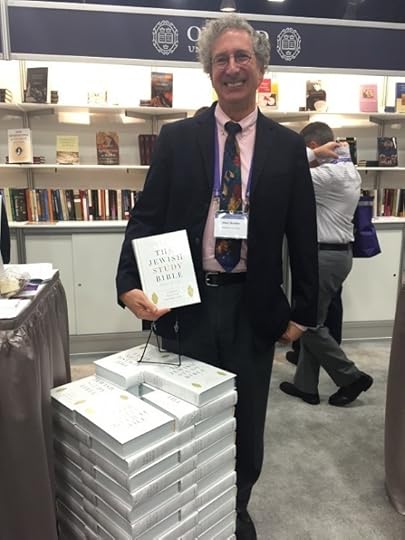
Marc Zvi Brettler
Marc Zvi Bretter holding the new edition of the Jewish Study Bible, which he co-edited
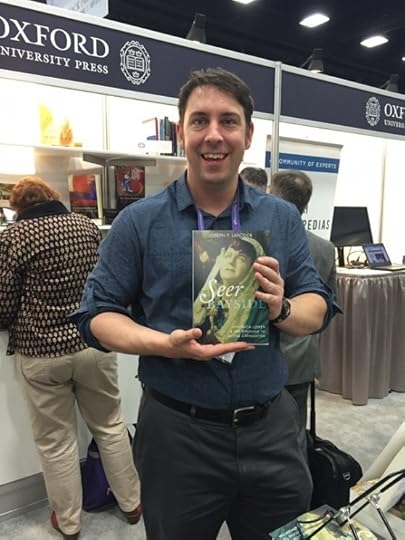
Joseph Laycock
Joseph Laycock with a copy of his just-published book, The Seer of Bayside: Veronica Lueken and the Struggle to Define Catholicism
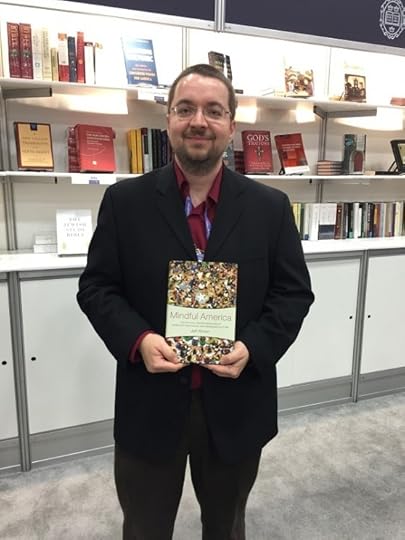
Jeff Wilson
Jeff Wilson holding a copy of his book, Mindful America: The Mutual Transformation of Buddhist Meditation and American Culture
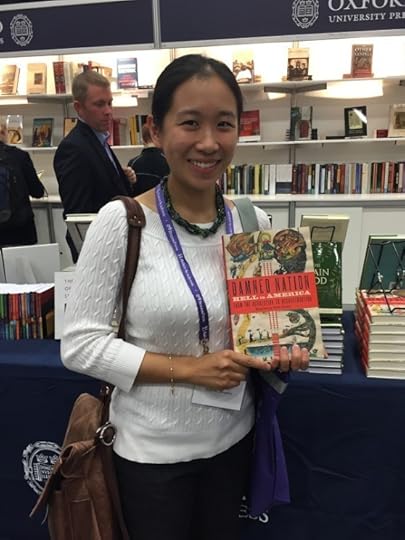
Kathryn Gin Lum
Kathryn Gin Lum displays a copy of her book,
Damned Nation: Hell in America from the Revolution to Reconstruction
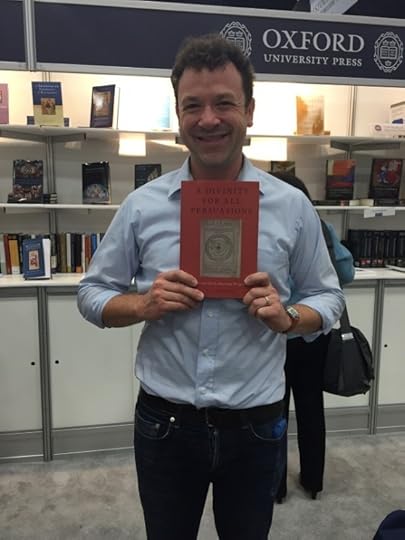
T.J. Tomlin
T.J. Tomlin holding a copy of his book, A Divinity for All Persuasions: Almanacs and Early American Religious Life
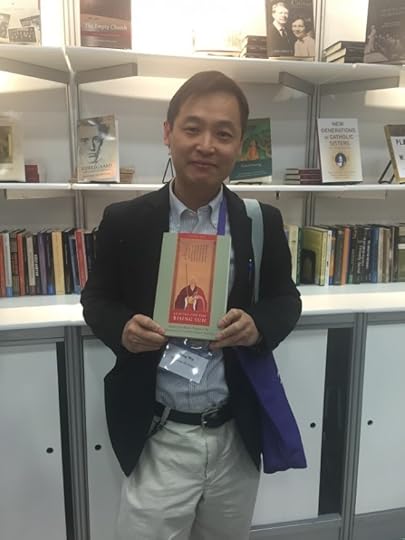
Jiang Wu
Jiang Wu with his book, Leaving for the Rising Sun: Chinese Zen Master Yinyuan and the Authenticity Crisis in Early Modern East Asia
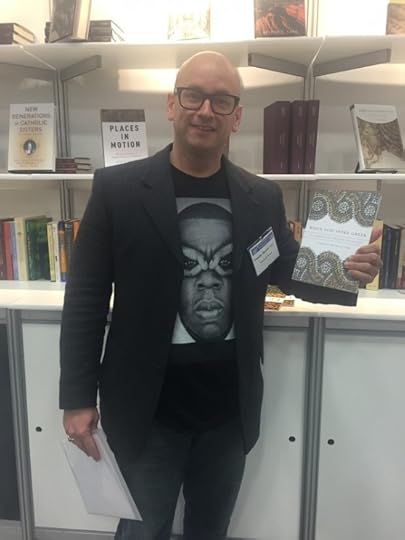
Timothy Michael Law
Timothy Michael Law with a copy of his book, When God Spoke Greek: The Septuagint and the Making of the Christian Bible

Eve Levavi Feinstein
Eve Levavi Feinstein with a copy of her book, Sexual Pollution in the Hebrew Bible
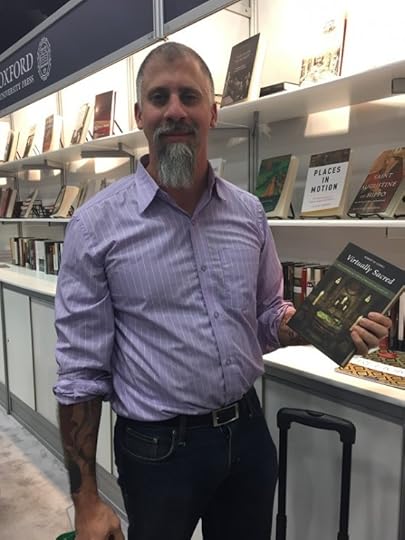
Robert Geraci
Robert Geraci holding a copy of his book, Virtually Sacred: Myth and Meaning in World of Warcraft and Second Life
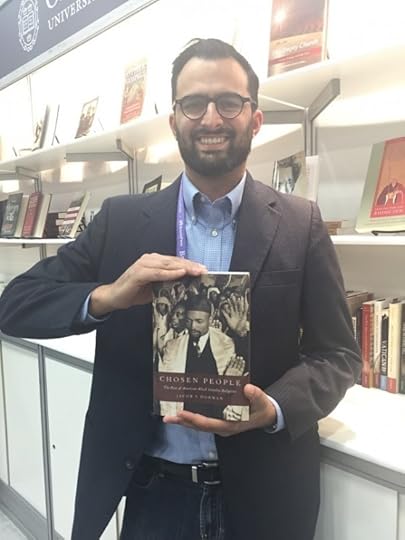
Jacob Dorman
Jacob Dorman with a copy of his book, Chosen People: The Rise of American Black Israelite Religions
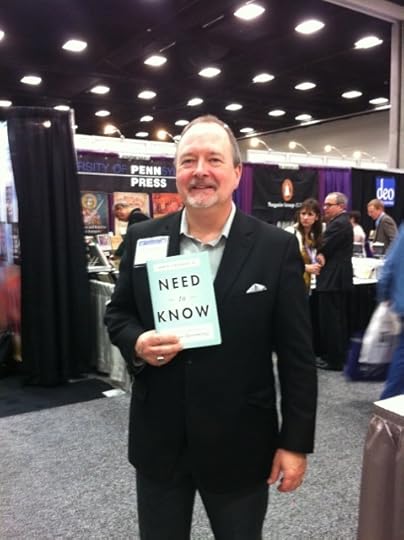
John Stackhouse
John Stackhouse with his new book, Need to Know: Vocation as the Heart of Christian Epistemology
Our conference discount is still good until 25 January 2015! Visit our webstore to browse our newest religion and theology books, and apply promotion code 32205 at checkout to received 20% off.
The post AAR/SBL 2014 annual meeting wrap-up appeared first on OUPblog.









 Related StoriesSan Diego, here we comeChristmas for a nonbelieverWilderness and redemption in Cheryl Strayed’s Wild
Related StoriesSan Diego, here we comeChristmas for a nonbelieverWilderness and redemption in Cheryl Strayed’s Wild
Gary King: an update on Dataverse
At the American Political Science Association meetings earlier this year, Gary King, Albert J. Weatherhead III University Professor at Harvard University, gave a presentation on Dataverse. Dataverse is an important tool that many researchers use to archive and share their research materials. As many readers of this blog may already know, the journal that I co-edit, Political Analysis, uses Dataverse to archive and disseminate the replication materials for the articles we publish in our journal. I asked Gary to write some remarks about Dataverse, based on his APSA presentation. His remarks are below.
* * * * *
An update on Dataverse
By Gary King
If you’re an academic researcher, odds are you’re not a professional archivist and so you probably have more interesting things to do when making data available than following the detailed protocols and procedures established over many years by the archiving community. That of course might be OK for any one of us but it is a terrible loss for all of us. The Dataverse Network Project offers a solution to this problem by eliminating transaction costs and changing the incentives to make data available by giving you substantial web visibility and academic citation credit for your data and scholarship (King, 2007). Dataverse Networks are installed at universities and other institutions around the world (e.g., here is the Dataverse network at Harvard’s IQSS), and represent the world’s largest collection of social science research data. In recent years, Dataverse has also been adopted by an increasingly diverse array of other fields and protocols and procedures are being built out to enable numerous fields of science, social science, and the humanities to work together.
With a few minutes of set-up time, you can add your own Dataverse to your homepage with a list of data sets or replication data sets you make available, with whatever levels of permission you want for the broader community, and a vast array of professional services (e.g., here’s my Dataverse on my homepage). People will be able to more easily find your data and homepage, explore your data and scholarship, find connections to other resources, download data in any format, and learn proper ways of citing your work. They will even be able to analyze your data while still on your web site with a vast array of statistical methods through the transparent and automated connection Dataverse has built to Zelig: Everyone’s Statistical Software, and through Zelig to R. The result is that your data will be professionally preserved and easier to access — effectively automating the tasks of professional archiving, including citing, sharing, analyzing, archiving, preserving, distributing, cataloging, translating, disseminating, naming, verifying, and replicating data.
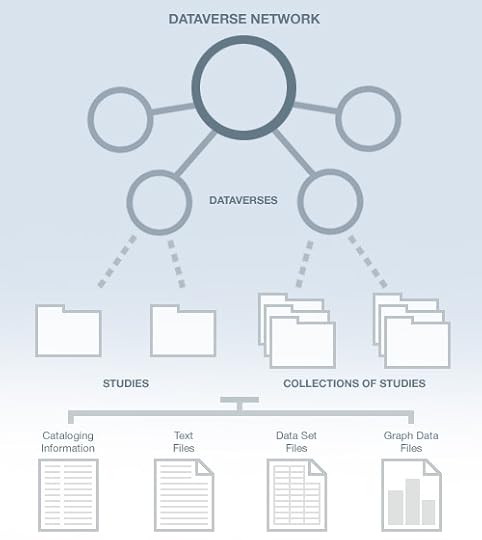 Dataverse Network Diagram, by Institute for Quantitative Social Science. CC-BY-2.0 via Wikimedia Commons.
Dataverse Network Diagram, by Institute for Quantitative Social Science. CC-BY-2.0 via Wikimedia Commons.Dataverse is an active project with new developments in software, protocols, and community connections coming rapidly. A brand new version of the code, written from scratch, will be available in a few months. Through generous grants from the Sloan Foundation, we have been working hard on eliminating other types of transaction costs for capturing data for the research community. These include deep integration with scholarly journals so that it can be trivially easy for an editor to encourage or require data associated with publications to be made available. We presently offer journals three options:
Do it yourself. Authors publish data to their own dataverse, put the citation to their data in their final submitted paper. Journals verify compliance by having the copyeditor check for the existence of the citation.
Journal verification. Authors submit draft of replication data to Journal Dataverse. Journal reviews it, and approves it for release. Finally, the dataset is published with a formal data citation and back to the article. (See, for example, the Political Analysis Dataverse, with replication data back to 1999.)
Full automation: Seamless integration between journal submission system and Dataverse; Automatic Link created between article and data. The result is that it is easy for the journal and author and many errors are eliminated.
Full automation in our third option is where we are heading. Already today, in 400 scholarly journals in the Open Journal System, the author enters their data as part of submission of the final draft of the accepted paper for publication, and the citation, permanent links between the data and the article, and formal preservation is taken care of, all automatically. We are working on expanding this as an option for all of OJS’s 5,000+ journals, and to a wide array of other scholarly journal publishers. The result will be that we capture data with the least effort on anyone’s part, at exactly the point where it is easiest and most important to capture.
We are also working on extending Dataverse to cover new higher levels of security that are more prevalent in big data collections and those in public health, medicine, and other areas with informative data on human subjects. Yes, you can preserve data and make it available under appropriate protections, even if you have highly confidential, proprietary, or otherwise sensitive data. We are working on other privacy tools as well. We already have an extensive versioning system in Dataverse, but are planning to add support for continuously updated data such as streamed from sensors, tools for online fast data access, queries, visualization, analysis methods for when data cannot be moved because of size or privacy concerns, and ways to use the huge volume of web analytics to improve Dataverse and Zelig.
This post comes from the talk I gave at the American Political Association Meetings August 2014, using these slides. Many thanks to Mike Alvarez for inviting this post.
Featured image: Matrix code computer by Comfreak. CC0 via Pixabay.
The post Gary King: an update on Dataverse appeared first on OUPblog.









 Related StoriesThe importance of mentoringTouchy-feely politicsDoes absence make the heart grow fonder?
Related StoriesThe importance of mentoringTouchy-feely politicsDoes absence make the heart grow fonder?
The Jerk Store called…and called and called
Seinfeld famously added a ton of terms to English, such as low talker, high talker, spongeworthy, and unshushables. It also made obscure terms into household words. Shrinkage and yada yada existed before Seinfeld, but it’s doubtful you learned them anywhere else.
Another successful Seinfeld term has gone under the radar: Jerk Store. The term was coined in “The Comeback,” when George is unselfconsciously stuffing his face with shrimp during a meeting. A co-worker sees George’s gluttony and says, “Hey, George, the ocean called. They’re running out of shrimp.” George is speechless, but later he crafts a comeback: “Oh yeah? Well, the Jerk Store called, and they’re running out of you.” The episode shows George going to absurd lengths to find a way to use his comeback, as well as his friends’ unwanted workshopping of the joke.
In a way, that workshopping has never ended—at least on Twitter, which is likely the largest collection of jokes, good and bad, by professionals and amateurs, ever created. Many of those jokes involve formulas, and the Jerk Store has become a popular one. On Twitter, every day is the Summer of George.
Most variations start with “The Jerk Store called,” which is as trusty a joke starter as “Relationship status:” and “When life hands you lemons.” From there, the joke can go just about anywhere. Comic Warren Holstein makes a food joke out of the formula: “The Jerk Store called but I couldn’t understand their thick Jamaican accents.” Matt Koff reveals what would likely happen to a real-life Jerk Store: “The Jerk Store called. It’s closing because it couldn’t compete with Amazon. :(“ Some use the formula to comment on politics: “The Jerk Store called; they’re no longer hiring because of fear of Obamacare mandates.” I particularly like this joke, which finds the funny in sadness: “The jerk store called. We didn’t chat for long but it was good to hear their voice. It was good to hear anyone’s voice. I’m so alone.”
Other tweeters abandon the formula when making Jerk Store jokes, like Laura Palmer: “I’m applying at the Jerk Store and I need references.” This holiday tweet sounds like perfect storm of jerkdom: “Looking forward to the Black Friday deals at the Jerk Store.” Food trends also get spoofed: “when will the jerk store start getting organic jerks. tired of getting these jerks full of gmos.” Here’s a particularly clever joke, playing on an annoying Frankenstein-related correction: “Actually, the jerk store’s monster called.”
This term/joke formula isn’t going anywhere for at least a few reasons. Seinfeld is still omnipresent in reruns, and I reckon the entire series is imprinted on the collective unconscious. Plus, the world is full of jerks. The following are some recent epistles from the Jerk Store to help you get through the polar jerk-tex. Jerk Store might never make the OED, but it’s one of the most successful joke franchises in the world.
The jerk store called, you left your credit card at the register. They are open until 8 if you want to pick it up today.
— Chris Hallbeck (@ChrisHallbeck) November 17, 2014
The Jerk Store called. They miss you. They love you. They just want you to come home.
— ben (@benicus_rex) November 13, 2014
The jerk store called. I didn't answer because I think it's unethical for jerks to be commodified & under a socialist system they'd be free
— thxgvng internet dad (@Fauxgyptian) September 15, 2014
O my sod, I am sorry for my sins w/ all my heart. In choosing to look out & failing to look within, I have ∞ voicemails from the jerk store
— lanyard (@lanyardigan) September 12, 2014
the jerk store called & they said that making television references from the 90s won’t stop the decay of all things. kind of a weird message
— dire dire deer (@m_kopas) November 17, 2014
I'm looking for a girl who's George at the Jerk Store and Elaine on the dance floor.
— Scott Dooley (@scottdools) August 23, 2014
The jerk store called.
The v-necks are on backorder Chad.
— Dani Fernandez (@msdanifernandez) June 8, 2014
The Jerk Store called, they're out of 30th anniversary DVDs with Steve Martin commentary
— Mattheim Sussroller (@suss2hyphens) May 18, 2014
The Jerk Store called…. again… [sigh]… dude, just give them back their shopping cart
— lemons (@respected_loner) June 28, 2014
Hey, the Jerk Store called, but there is a new Jerk Outlet out by the highway and they have much better prices let's go on Saturday.
— Trademarked Name™ (@rj_white) June 17, 2014
Who would even OPEN a jerk store?!
— |\/|∆®|{•├┤Ø%û5 (@markhoppus) October 31, 2014
Headline image credit: Seinfeld logo. Public domain via Wikimedia Commons.
The post The Jerk Store called…and called and called appeared first on OUPblog.









 Related StoriesThe Oxford Dictionaries Word of the Year is…vapeYes? Yeah….Monthly etymology gleanings for November 2014
Related StoriesThe Oxford Dictionaries Word of the Year is…vapeYes? Yeah….Monthly etymology gleanings for November 2014
Christmas for a nonbeliever
As a small boy in the 1920s, my father sang in the choir of the parish church, St Matthews, in Walsall in the British Midlands. Twenty years later, he was married with a couple of children and our small, tight family belonged to the Religious Society of Friends, the Quakers. Friends do not have church services. There is no hymn singing. But every Christmas Eve, religiously as one might say, at three o’clock in the afternoon, the family gathered around the radio to listen to the broadcast of carols and lessons from King’s College, Cambridge.
That was long ago and for me, since I now live in Florida, far away. I have long since lost my faith in the Christian religion. Even if this were not so, I doubt that I would much enjoy Christmas overall. When the kids were little, it was a lot of fun. But now, it strikes me as appallingly commercialized and an occasion when you spend way too much on presents no one really wants, eat and drink to excess, and end by quarreling with people that you have not seen for a year and by which time you both realize why it is that you have not seen each other for a year.
But every Christmas Eve I track down the broadcast of the King’s service and listen to it, even though because of time-zone differences it is now for me in the morning. Music spurs emotions as does no other art form, and I find listening an almost-melancholic experience as memories of my childhood come flooding in and I recall with huge gratitude the loving family into which I was born. I remember also my dedicated teachers recreating civilized life after the horrendous conflicts of the first part of the century. How can one speak except with respect of a man who spent the first half of the decade driving a tank over North Africa and Western Europe, and the second half explaining to nine-year olds why Pilgrim’s Progress is such a tremendous story and something of vital relevance to us today?
 Christmas lights, by shannonpareil, CC-by-2.0 via Flickr
Christmas lights, by shannonpareil, CC-by-2.0 via FlickrSo Christmas remains very important for me, as does the other great highlight of the Christian calendar. As a teenager, having failed O level German miserably, I was packed off one Easter vacation to stay with a family in Germany, so I could (as I did) succeed on the second attempt. Music again. On Good Friday, German radio stations played Bach’s Matthew Passion, and listening to that – even though in respects I prefer the dramatic intensity of the St John Passion – has remained a life-long practice.
Perhaps because it is all so German, I find myself focusing on the dreadful events of the Third Reich, but also – and obviously the theme of Christ’s sacrifice is all-important here – on those who showed super-human qualities in the face of absolute evil and terror. Above all, Sophie Scholl, at twenty-one years old a member of the White Rose group in Munich who started handing out anti-Nazi pamphlets in the middle of the war. Inevitably discovered and condemned to death, as she was led to the guillotine, she said: “How can we expect righteousness to prevail when there is hardly anyone willing to give himself up individually to a righteous cause. Such a fine, sunny day, and I have to go, but what does my death matter, if through us, thousands of people are awakened and stirred to action?”
I would not for anything relinquish the experience of Easter and the moments when I contemplate the truly good people – I think of those combating Ebola in West Africa – who stand so far above me and who inspire me, even though I am not worthy to clean their shoes. You don’t have to have religious faith to have these all-important emotions. You do have to be a human being.
“How can we expect righteousness to prevail when there is hardly anyone willing to give himself up individually to a righteous cause.”
And so finally to the third festival, that of Thanksgiving. Growing up in England, it was something unknown to me until, to go to graduate school, I crossed the Atlantic in 1962. In the early years, in both Canada and America, people invited me into their homes to share the occasion with their family and friends. This is something that has stayed with me for over fifty years, and now at Thanksgiving – by far my favorite festival overall — my wife and I hugely enjoy filling the table with folk who are away from home or for one reason or another would not otherwise have a place to be. No special music this time – although I usually manage to drive everyone crazy by playing opera at full blast – but for me an equally poignant occasion when I reflect on the most important thing I did in my life – to move from the Old Word to the New – and on the significance of family and friends and above all of giving. In the Republic, Plato says that only the good man is the happy man. Well, that’s a bit prissy applied to me, but I know what he means. People were kind to me and my wife and I try to be kind to people. That is a wonderful feeling.
Three festivals – memories and gratitude; sacrifice and honor; giving and friendship. That is why, although I have not a scrap of religious belief and awful though the music in the mall may be, I look forward to Christmas, and then to Easter, and then to Thanksgiving, and to the cycle all over again, many times!
The post Christmas for a nonbeliever appeared first on OUPblog.









 Related StoriesThe impossible paintingWilderness and redemption in Cheryl Strayed’s WildTouchy-feely politics
Related StoriesThe impossible paintingWilderness and redemption in Cheryl Strayed’s WildTouchy-feely politics
December 6, 2014
Music from Scotland: a playlist
When one thinks of traditional Scottish music, one instrument usually comes to mind: the bagpipe. Although bagpipes are prominent in traditional music from Scotland, Scottish music branches far out beyond that. In light of Scotland receiving the title of Place of the Year for 2014, we’ve put together a brief playlist of music from Scotland, from chamber music to modern classical.
To learn more about Scotland and why it was voted Place of the Year for 2014, read our Place of the Year archive.
Headline image credit: Photo by PublicDomainArchive. CC0 Public Domain via Pixabay.
The post Music from Scotland: a playlist appeared first on OUPblog.









 Related StoriesAn excerpt from Scotland: A Very Short IntroductionLooking back at Scotland in 2014Place of the Year 2014 nominee spotlight: Scotland [quiz]
Related StoriesAn excerpt from Scotland: A Very Short IntroductionLooking back at Scotland in 2014Place of the Year 2014 nominee spotlight: Scotland [quiz]
Oxford University Press's Blog
- Oxford University Press's profile
- 238 followers



